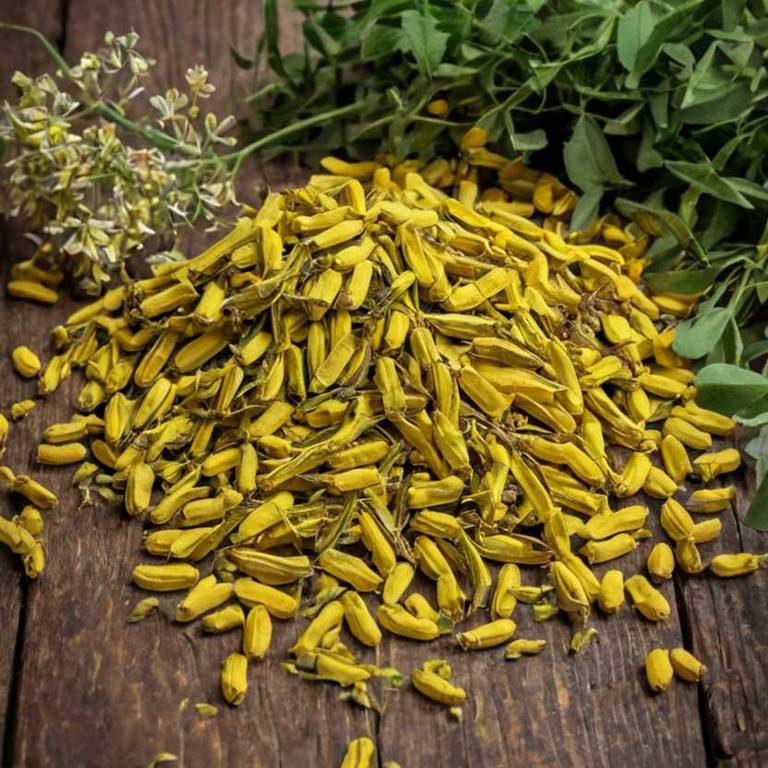By Leen Randell
Updated: Jul 21, 2024
10 Medicinal Constituents Of Cassia Senna (Senna)

Cassia senna has active constituents such as anthraquinones (emodin, aloe-emodin, rhein, and chrysophanic acid), flavonoids, and sennosides.
These compounds exhibit purgative, anti-inflammatory, and antimicrobial properties. The medicinal properties of Cassia senna help alleviate constipation, reduce pain and inflammation, and combat bacterial infections.
For example, the anthraquinones can improve bowel movements and relieve symptoms of irritable bowel syndrome, while the flavonoids can enhance the immune system and reduce oxidative stress.
This article explains in details the 10 best active constituents of Cassia senna .
1. Sennoside a
Cassia senna sennoside A is a naturally occurring glycoside compound found in the leaves of the Cassia acutifolia plant.
It is a key active ingredient in traditional herbal remedies for treating constipation and other digestive issues. Sennoside A works by stimulating the gut to move food through the intestines and helping to soften stool, making it easier to pass.
Its effectiveness has been extensively studied and widely used as a safe and natural treatment option.
2. Sennoside b
Cassia senna sennoside B is a natural laxative extracted from the leaves of the Cassia angustifolia plant.
It is a glycoside that stimulates the bowel movement and helps to treat constipation by increasing the frequency and ease of defecation.
Sennoside B has been used for centuries in traditional medicine to relieve symptoms of irritable bowel syndrome (IBS) and other digestive disorders.
3. Aloin
Cassia senna aloin is a naturally occurring laxative that has been used for centuries to treat constipation and other digestive issues.
Derived from the leaves of the Cassia angustifolia plant, it is a type of anthraquinone glycoside that stimulates bowel movements by increasing peristalsis and reducing water absorption in the colon.
4. Chrysophanic acid
Cassia senna chrysophanic acid is a yellowish-orange pigment extracted from the leaves of the Cassia auriculata plant.
This anthraquinone derivative has been used in traditional medicine for centuries to treat various health issues, including liver and gallbladder disorders, constipation, and skin conditions. It has also shown potential as an anti-inflammatory agent and antioxidant.
Chrysophanic acid is believed to exert its effects by stimulating bowel movements, improving digestion, and reducing inflammation.
5. Anthraquinones
Cassia senna anthraquinones is a group of compounds that are responsible for the laxative properties of the plant.
These compounds include sennosides A and B, which are responsible for stimulating bowel movements and relieving constipation. Anthraquinones work by irritating the lining of the colon, increasing muscle contractions and stool frequency, and reducing water absorption in the gut.
This natural remedy has been used for centuries to treat a range of digestive issues, including irritable bowel syndrome and chronic constipation.
6. Catechins
Cassia senna catechins is a type of polyphenol antioxidant found in the leaves of the Cassia angustifolia plant.
These compounds have been studied for their potential health benefits, including anti-inflammatory and antibacterial properties. Catechins may help protect against chronic diseases such as cardiovascular disease, cancer, and neurodegenerative disorders by neutralizing free radicals and reducing oxidative stress.
Additionally, they may also contribute to the plant's traditional use in herbal medicine for its laxative and digestive properties.
7. Flavonoids
Cassia senna flavonoids is a group of bioactive compounds that are present in the leaves and stems of the Senna alexandrina plant.
These flavonoids have been shown to exhibit antioxidant, anti-inflammatory, and antimicrobial properties, making them potential therapeutic agents for various diseases.
They have also been found to possess estrogenic and cardioprotective activities, suggesting their potential use in the prevention and treatment of certain health conditions.
8. Phenolic acids
Cassia senna phenolic acids is a group of bioactive compounds extracted from the leaves and flowers of Senna alexandrina.
These phenolic acids have been extensively studied for their potential health benefits, including antioxidant, anti-inflammatory, and antimicrobial properties.
They are also known to exhibit laxative effects due to their ability to stimulate bowel movement and soften stool.
9. Quercetin
Cassia senna quercetin is a flavonoid compound found in the leaves of the Senna auriculata plant.
It has been traditionally used in Ayurvedic medicine to treat various health conditions such as skin and eye disorders, as well as digestive issues.
Quercetin has potent antioxidant and anti-inflammatory properties, making it a potential natural remedy for reducing inflammation and oxidative stress.
10. Kaempferol
Cassia senna kaempferol is a flavonoid compound extracted from the leaves of Senna alexandrina, a plant commonly used in traditional medicine and herbal remedies.
Kaempferol has been shown to possess potent antioxidant properties, inhibiting inflammation and oxidative stress, which may contribute to its potential therapeutic benefits for various diseases, including cardiovascular and neurodegenerative disorders.